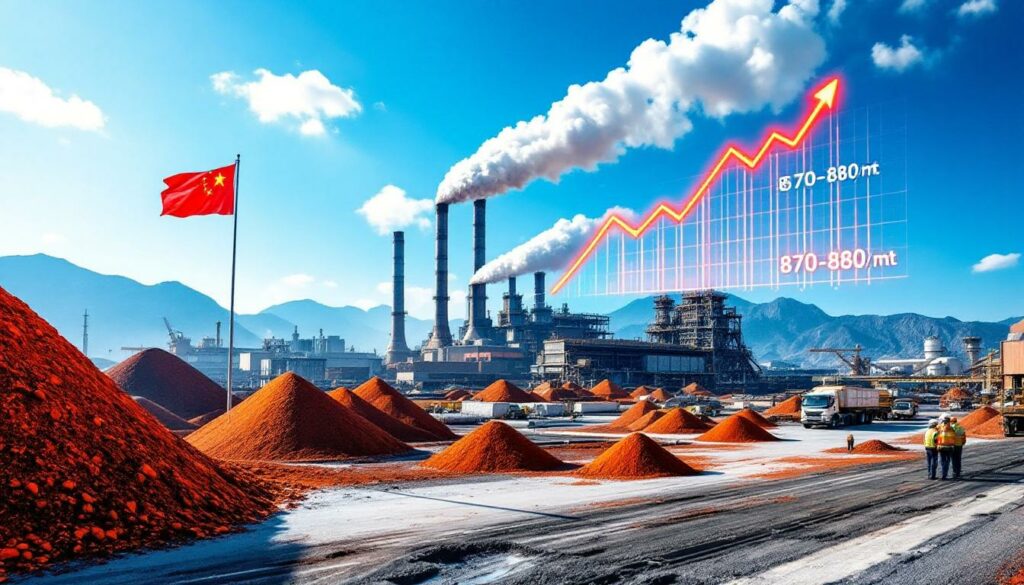Tangshan Iron Ore Market Analysis: Current Trends and Future Outlook
The iron ore market in China's Tangshan region continues to demonstrate remarkable resilience amid evolving supply-demand dynamics. As one of China's primary steel-producing hubs, Tangshan's iron ore price trends serve as a crucial barometer for the broader Chinese metals industry. This comprehensive analysis explores current market conditions, influential factors, and projections for iron ore concentrate prices in this vital industrial center.
What Is the Current State of Iron Ore Prices in Tangshan?
Current Price Range and Market Stability
Iron ore prices in Tangshan have maintained relative stability in early July 2025, despite fluctuating market conditions. According to the latest data from Shanghai Metal Market (SMM), local delivery-to-factory prices for 66% grade dry-basis iron ore concentrates (tax included) currently range between 870 to 880 yuan per metric ton (yuan/mt).
Transaction volumes have noticeably slowed in recent weeks, creating what industry analysts describe as a "supply-demand stalemate." This equilibrium has contributed to price stability, despite reduced trading activity. Steel producers have shifted toward more conservative procurement strategies, primarily purchasing raw materials on an as-needed basis rather than building substantial inventories.
The price stability witnessed in Tangshan represents a delicate balance between production costs and demand fundamentals, with neither side gaining significant leverage in current negotiations.
Regional Supply Dynamics
A significant development affecting Tangshan's iron ore market is the recent influx of resources from neighboring Shandong province into Hebei. This cross-provincial movement has altered traditional supply patterns, improving resource outflow and distribution efficiency across the region.
Local concentrators have maintained firm asking prices despite the increased regional supply, primarily due to their cost structures. This price discipline has prevented potential downward pressure that might otherwise result from improved resource availability.
Industry experts note that these interregional material flows create both challenges and opportunities for market participants. While increased supply options benefit steel producers, the maintained price discipline from concentrators prevents significant cost advantages from materializing.
What Factors Are Influencing Iron Ore Prices in Tangshan?
Production Cost Pressures
Rising raw material costs represent one of the most significant factors supporting current iron ore price levels in Tangshan. Local concentrators face substantial production cost pressures, creating strong resistance to potential price decreases.
According to SMM market analysis, producers are maintaining firm asking prices specifically due to "recent rise in raw material costs and high production costs." This cost-based pricing strategy has established effective price floors in the market, even as transaction volumes have slowed.
The production economics for iron ore concentrators create a natural limit to how low prices can fall, as producers resist selling below cost-recovery thresholds. This dynamic has been particularly evident in early July 2025, as concentrators hold firm on pricing despite slower sales volumes.
Demand-Side Factors
Steel mill operations in Tangshan continue to support iron ore demand insights, with blast furnaces maintaining high utilization rates. According to SMM data, "pig iron production of steel mill blast furnaces remains at high levels," providing fundamental support for iron ore concentrate demand.
This operational continuity in steel production helps explain the market's current equilibrium. While mills have become more cautious in their purchasing strategies, their consistent production requirements prevent significant demand erosion.
The need-based acquisition patterns from steel producers have limited price volatility while ensuring steady consumption of iron ore concentrates. This balanced approach to resource procurement has contributed to the market's overall stability.
Market Sentiment and Futures Impact
Iron ore futures markets have demonstrated strengthening trends in recent weeks, creating positive sentiment that translates to physical market support. This futures performance has established upward price pressure that counterbalances the cautious purchasing strategies employed by steel producers.
The interplay between spot and futures markets has become increasingly significant in Tangshan's pricing ecosystem. As futures prices strengthen, spot market participants adjust expectations accordingly, reinforcing confidence in stable-to-higher price projections.
Market psychology plays a crucial role in this dynamic, with trader sentiment influenced by both fundamental factors and derivatives market signals. The recent positive performance in iron ore futures has created anticipatory positioning that supports current price levels.
Why Is There Upside Potential for Iron Ore Concentrate Prices?
Supply-Demand Balance Analysis
The changing patterns of resource flow between provinces have created conditions favorable for potential price increases. The movement of materials from Shandong to Hebei has altered traditional supply channels, but has not resulted in oversupply conditions that might depress prices.
SMM analysts note improved resource outflow patterns in early July, suggesting distribution efficiency gains that benefit producers. These supply chain adjustments occur against a backdrop of sustained industrial demand, creating a balanced market environment.
The supply constraints within this dynamic help explain why transaction volumes have slowed without corresponding price decreases. This balance of forces creates the potential for upside price movement as the market adjusts to evolving supply channel configurations.
Production Cost Support Levels
Elevated raw material costs establish effective price floors that limit downside potential while creating room for upward movement. Producer resistance to selling below cost-recovery points has maintained price discipline throughout the supply chain.
This cost-based pricing strategy remains central to market dynamics in Tangshan. As manufacturing expenses increase, these costs are inevitably passed through the supply chain, creating upward pressure on iron ore concentrate prices.
"Local concentrates producers, considering the recent rise in raw material costs and high production costs, maintained firm asking prices." — SMM Market Analysis (July 8, 2025)
The economics of iron ore concentration, particularly for premium 66% grade products, support this upside potential. Production costs establish minimum viable price points that, when combined with steady demand, create conditions for potential price increases.
Industrial Demand Sustainability
Continued high utilization rates at steel mill blast furnaces provide the demand foundation necessary for potential price increases. According to SMM data, pig iron production remains robust, sustaining iron ore requirements despite cautious purchasing behavior.
This industrial activity provides fundamental demand support that underpins the market. While steel mills have become more strategic in their procurement approaches, their operational requirements ensure consistent consumption of iron ore concentrates.
Manufacturing sector resilience in Tangshan and surrounding regions maintains the consumption levels necessary for price stability with upside potential. This steady industrial demand creates the conditions for potential price increases as market dynamics continue to evolve.
How Are Steel Mills Responding to Current Market Conditions?
Purchasing Strategy Adjustments
Steel producers in Tangshan have shifted toward need-based procurement approaches in response to current market conditions. According to SMM analysis, "steel mills are currently focusing on purchasing as needed," reflecting a more cautious approach to inventory management.
This strategic purchasing behavior represents an effort to manage input costs while maintaining operational continuity. By reducing inventory building compared to previous periods, mills seek to minimize price risks while ensuring sufficient materials for production requirements.
The balanced approach to resource acquisition demonstrates the sophisticated inventory management strategies employed by Tangshan's steel producers. This calculated approach helps explain the current market equilibrium, with neither buyers nor sellers gaining significant leverage.
Production Level Maintenance
Despite their cautious purchasing strategies, steel mills continue to maintain high blast furnace utilization rates. This operational continuity supports consistent iron ore demand, even as procurement approaches become more strategic.
The steady pig iron production despite market uncertainties creates predictable consumption patterns that benefit iron ore suppliers. This production stability represents a crucial factor in the overall market dynamic, providing the demand foundation necessary for potential price increases.
Manufacturing output consistency creates the reliable consumption patterns that support current price levels with upside potential. As one SMM analyst noted, "pig iron production of steel mill blast furnaces remains at high levels," providing fundamental support for iron ore concentrate demand.
What's the Outlook for Tangshan Iron Ore Prices?
Short-Term Price Projections
Industry analysts anticipate modest price increases for Tangshan's iron ore concentrates in the coming weeks. According to SMM's market assessment, "it is expected that local iron ore concentrate prices still have some room for further increases."
This upside potential is supported by current market fundamentals, including production cost pressures, steady demand, and positive futures performance. The combination of these factors creates conditions favorable for price appreciation despite cautious purchasing by steel producers.
Cost pressures are likely to prevent significant price decreases, establishing a solid foundation for potential upward movement. As one market participant noted, "local iron ore concentrate prices still have some room for further increases," reflecting confidence in the market's direction.
Market Indicators to Monitor
Several key indicators will determine the trajectory of Tangshan's iron ore prices in the near term. Futures market performance serves as a leading indicator, with recent strength suggesting positive momentum for physical prices.
Steel mill production rate adjustments represent another crucial metric to watch. Any changes in blast furnace utilization would directly impact iron ore demand, potentially altering the current market equilibrium.
Cross-regional resource flows, particularly between Shandong and Hebei provinces, will continue to influence local supply conditions. Additionally, raw material cost trajectories will affect producer pricing strategies, potentially reinforcing upward price pressure.
Regional Competitive Dynamics
The impact of Shandong-sourced materials on Tangshan pricing illustrates the importance of regional competitive dynamics. This inter-provincial competition affects regional price differentials, creating opportunities and challenges for market participants.
Supply chain adjustments influence price formation as materials flow between provinces. The geographic arbitrage opportunities created by these regional differentials shape market flows and contribute to the overall pricing environment.
Understanding these regional dynamics provides valuable context for anticipating price movements in Tangshan's iron ore market. As these competitive forces evolve, they will continue to influence price formation in this crucial industrial hub.
FAQ About Tangshan Iron Ore Market
How do iron ore concentrates differ from other iron ore products?
Iron ore concentrates undergo sophisticated beneficiation processes to increase iron content, typically reaching 65-68% Fe content compared to lower-grade ores. This higher iron content makes concentrates more efficient for steel production, reducing impurities and improving blast furnace productivity.
The premium quality of these concentrates explains their price premium in markets like Tangshan. The 66% grade concentrates referenced in current pricing (870-880 yuan/mt) represent high-quality products that command premium pricing due to their efficiency advantages in steel production.
What is the significance of the Tangshan region in China's steel industry?
Tangshan stands as one of China's largest steel-producing regions, located in Hebei province approximately 150 kilometers east of Beijing. The area's iron ore pricing often serves as a benchmark for domestic Chinese markets, with significant influence on national steel production costs.
The region's concentration of blast furnaces and integrated steel mills creates substantial demand for iron ore products. This industrial concentration makes Tangshan's pricing trends particularly significant for understanding broader Chinese steel industry dynamics.
How do domestic iron ore prices in Tangshan compare to international benchmark prices?
Domestic Chinese iron ore prices, including those in Tangshan, often trade at a premium to international benchmarks due to quality specifications, logistics costs, and import policies. This premium varies based on local supply-demand dynamics and regulatory considerations.
The current 870-880 yuan/mt price range for 66% concentrates reflects this premium positioning in the domestic market. While international prices provide broader context, local factors in Tangshan create distinct pricing dynamics that may diverge from global benchmarks.
What role do futures markets play in physical iron ore pricing in Tangshan?
Futures markets provide forward price discovery and risk management tools that significantly influence spot market sentiment in Tangshan. Strong futures performance typically creates upward price pressure on physical prices as traders anticipate future market conditions.
Recent strengthening in iron ore futures has contributed to the positive outlook for physical prices in Tangshan. This relationship between derivatives and physical markets illustrates the increasingly sophisticated financial dimension of iron ore price forecast modeling in China.
Understanding various market types and deposits is crucial for market participants navigating the complex surplus impact analysis that influences Tangshan's pricing environment.
Disclaimer: This market analysis contains forward-looking statements and projections based on current data and industry expertise. Actual market conditions may vary, and readers should conduct their own due diligence before making business or investment decisions based on this information. All price references and projections are for informational purposes only and should not be considered as investment advice.
Ready to Stay Ahead in the Iron Ore Market?
Discover critical insights on mining developments before the market with Discovery Alert's proprietary Discovery IQ model, providing real-time alerts on significant ASX mineral discoveries that could impact iron ore investments. Explore why major mineral discoveries lead to substantial returns by visiting Discovery Alert's dedicated discoveries page and position yourself for market-leading advantage.




